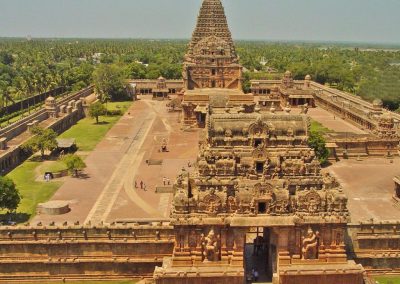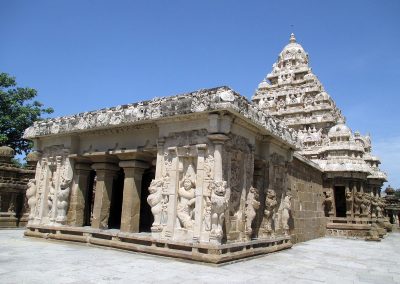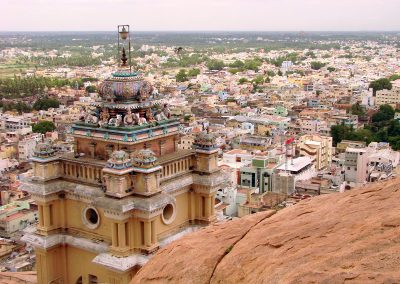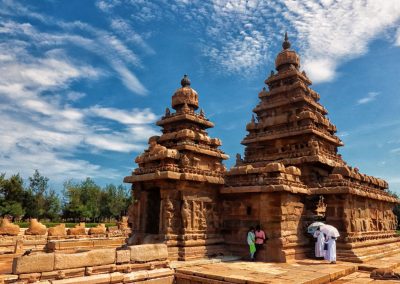Chennai
With its historic landmarks and buildings, long sandy beaches, cultural and art centers and parks, Chennai’s tourism offers many potentially interesting locations to visitors. A notable tourist attraction in Chennai is actually in the neighbouring town of Mahabalipuram, with its ancient temples and rock carvings of the 7th century Pallava kingdom is an UNESCO World Heritage site
Tirupati
Kanchipuram
Kanchipuram also known as Conjeevaram, is a city in the Indian state of Tamil Nadu in the Tondaimandalam region, 72 km (45 mi) from Chennai – the capital of Tamil Nadu. Known as the City of Thousand Temples, Kanchipuram is known for its temple architectures, 1000-pillared halls, huge temple towers and silk sarees. Kanchipuram serves as one of the most important tourist destinations in India. Kanchipuram has become a centre of attraction to the foreign tourists as well.
Kanchipuram is a Tamil word formed by combining two words “Kanchi” and “-puram” meaning “Brahma” and “residential place” respectively and located on the banks of the Vegavathy and Palar river. Kanchipuram has been ruled by the Pallavas, the Medieval Cholas, the Later Cholas, the Later Pandyas, the Vijayanagara Empire, the Carnatic kingdom, and the British, who called the city “Conjeeveram”. The city’s historical monuments include the Kailasanathar Temple and the Vaikunta Perumal Temple. Historically, Kanchipuram was a centre of education and was known as the ghatikasthanam, or “place of learning”. The city was also a religious centre of advanced education for Jainism and Buddhism between the 1st and 5th centuries.
Mamallapuram
Mamallapuram, also known as Mahabalipuram, is a town in Chengalpattu district in the southeastern Indian state of Tamil Nadu, best known for the UNESCO World Heritage Site of 7th- and 8th-century Hindu Group of Monuments at Mahabalipuram. It is one of the famous tourist sites in India. The ancient name of the place is Thirukadalmallai.
Mamallapuram was one of two major port cities in the Pallava kingdom. The town was named after Pallava king Narasimhavarman I, who was also known as Mamalla. Along with economic prosperity, it became the site of a group of royal monuments, many carved out of the living rock. These are dated to the 7th and 8th centuries: rathas (temples in the form of chariots), mandapas (cave sanctuaries), the giant open-air rock relief the Descent of the Ganges, and the Shore Temple dedicated to Shiva. The contemporary town plan was established by the British Raj in 1827.
Thanjavur
The city first rose to prominence during the reign of the Cholas when it served as the capital of the empire. After the fall of the Cholas, the city was ruled by various dynasties such as the Mutharaiyar dynasty, the Pandyas, the Vijayanagar Empire, the Madurai Nayaks, the Thanjavur Nayaks, the Thanjavur Marathas and the British Empire. It has been a part of independent India since 1947.
Tiruchirappalli
Tiruchirappalli’s recorded history begins in the 3rd century BC, when it was under the rule of the Cholas. The city has also been ruled by the Pallavas, Pandyas, Vijayanagar Empire, Nayak Dynasty, the Carnatic state and the British. The most prominent historical monuments in Tiruchirappalli include the Rockfort at Teppakulam, the Ranganathaswamy temple at Srirangam dedicated to the reclining form of Hindu God Vishnu, and is also the largest functioning temple in the world, and the Jambukeswarar temple at Thiruvanaikaval, which is also the largest temple for the Hindu God Shiva in the world. The archaeologically important town of Uraiyur, capital of the Early Cholas, is now a neighbourhood in Tiruchirappalli. The city played a critical role in the Carnatic Wars (1746–1763) between the British and the French East India companies.
Madurai
Madurai is closely associated with the Tamil language. The third Tamil Sangam, a major congregation of Tamil scholars said to have been held in the city. The recorded history of the city goes back to the 3rd century BCE, being mentioned by Megasthenes, the Greek ambassador to the Maurya empire, and Kautilya, a minister of the Mauryan emperor Chandragupta Maurya. Signs of human settlements and Roman trade links dating back to 300 BCE are evident from excavations by Archeological Survey of India in Manalur. The city is believed to be of significant antiquity and has been ruled, at different times, by the Pandyas, Cholas, Madurai Sultanate, Vijayanagar Empire, Madurai Nayaks, Carnatic kingdom, and the British East India Company British Raj.
The city has a number of historical monuments, with the Meenakshi Temple and the Thirumalai Nayak Palace being the most prominent. Madurai is an important industrial and educational hub in South Tamil Nadu. The city is home to various automobile, rubber, chemical and granite manufacturing industries.









